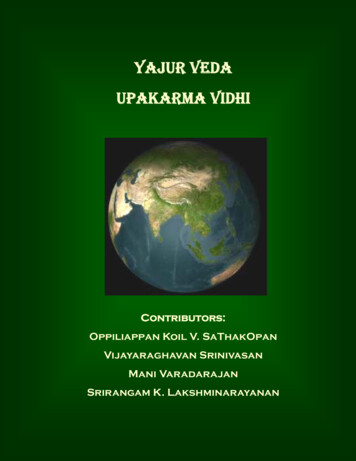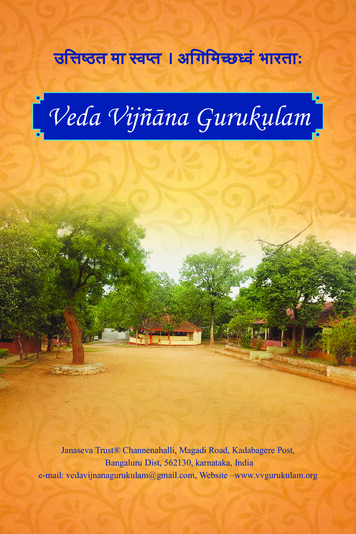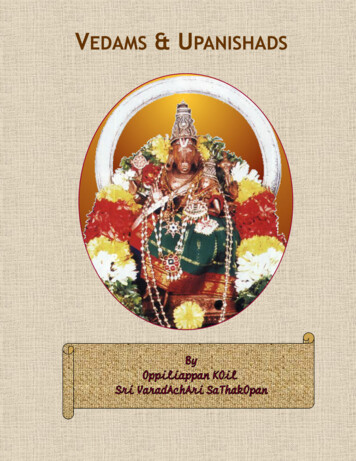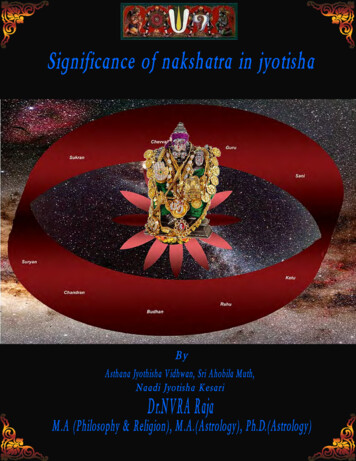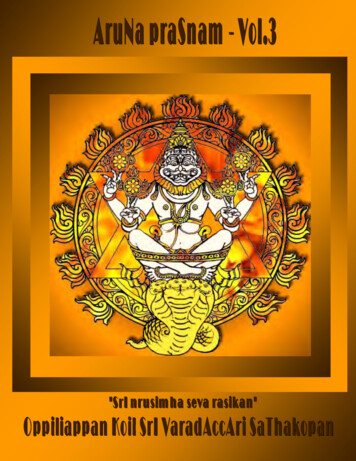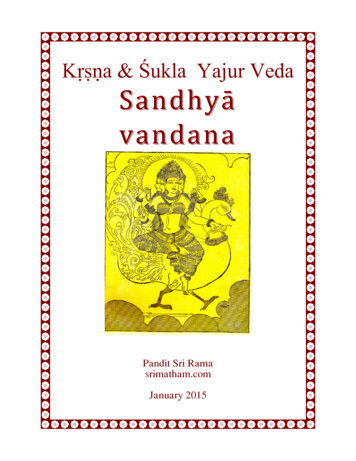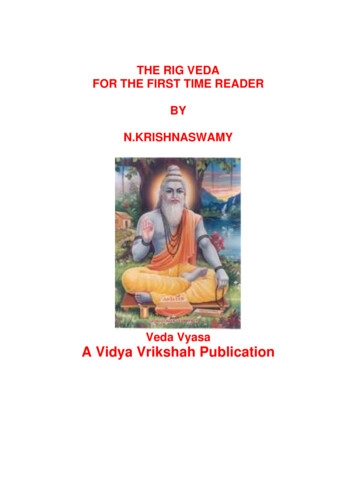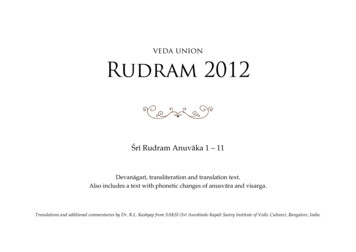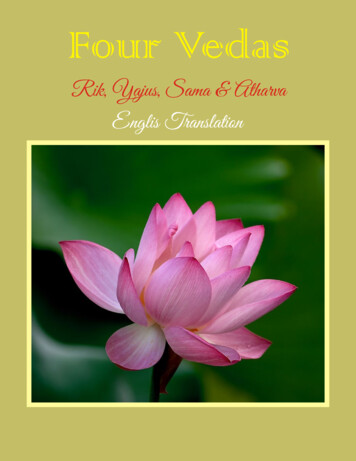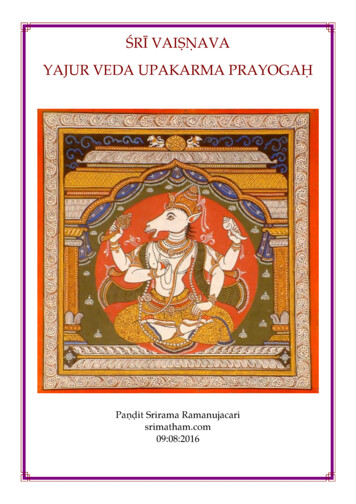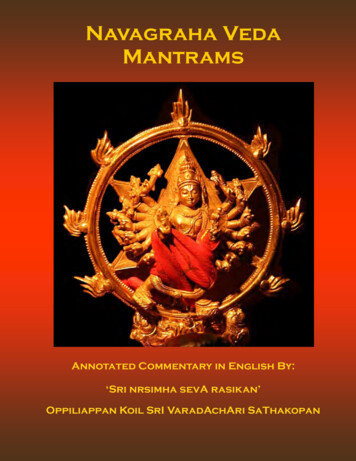
Transcription
Navagraha VedaMantramsAnnotated Commentary in English By:‘Sri nrsimha sevA rasikan’Oppiliappan Koil SrI VaradAchAri SaThakopan
sadagopan.orgSincere Thanks To:1. Mannargudi SrI Srinivasan Narayanan for compiling the source doc, providing Sanskrit text and proof reading2. www.pbase.com/svami, www.thiruvarangam.com, SrI B Senthil Kumar, SrIVenkat and others for images3. Smt Mythreyi Ananth (SrIrangam/Japan) for eBook assembly
ContentsIntroduction1Mantrams and Meanings9sUrya11angArakan15Sukra19soma (candra)23budhan29brhaspati (Guru)33SanaiScara (Sani)39rAhu43Ketu47nigamanam52anubandham I -53SrI Mutthuswamy DIkshitar krits with translation by(Late) Dr. T. McCombanubandham II – URL for navagraha slokams94sadagopan.orgPage
sadagopan.orgSrI sudarSanar - SrIrangam
. ïI .Navagraha Veda MantramsINTRODUCTION:For them Navagraha Saanti is obtained by reciting specific slokams of SriRanganAtha PaadukA Sahasram (SRPS) of Swamy Desikan. The recitation ofthe 749th slokam of SRPS with the following sankalpam will result in NavagrahaDevatA PrasAdam.The 749thslokam and its meaning as well ascommentaries have been housed at the Sundarasimham web site (25th e-book,Part 4 and Page 482):http://www.sundarasimham.orgLord RanganAthA's Paadukai is Swamy NammAzhwAr, the Supreme mostSadAcAryan. Links (sambandhams) with Him will chase away the Navagrahadoshams and confer auspiciousness at all times .Any one seeking relief from inauspiciousness caused by the Nava grahams willrecite the 749th Slokam preceded by the following Sankalpam seeking theanugraham of Lord's Paadukais:ïI ïIr¼naiyka smet ïI r¼nawSvaimn Anu he[ mm nv h devta àsad isÏ(w¡ ïIr¼naw idVymi[ paÊka shöSlaek mNÇ jpmh kir:ye,1sadagopan.orgThe ParamaikAntis who have performed Prapatti at the sacred feet of SrimannArAyaNan will not seek any anya devatais like nava Grahams to seek redressfrom samsAric sufferings.
SrI SrIranganAyikA sameta SrI ranganAtha svAmina: anugraheNa mama navagraha devatA prasAda siddhyartham, SrI ranganAtha divya maNi paadukAsahasra sloka mantra japamaham karishye The 749th slokam is recited for 10, 28 or 108 times per day for a MaNDalam orshorter periods. The slokam is:knkéicra kaVyaOyata znEír[aeictaiïtguébuxa ÉaSvÔUpa iÖjaixpseivta,sadagopan.orgivihtivÉva inTy iv:[ae pde mi[paÊkeTvmis mhit ivñe;a n zuÉa hm{flI.kanakarucirA kAvyAkhyAtA SanaiScaraNocitASritagurubudhA bhAsvadrUpA dvijAdhipasevitA vihitavibhavA nityam vishhNo: pade maNipAduketvamasi mahati viSveshAm na: SubhA grahamaNDalI ---SrI RanganAtha pAduka sahasram, Slokam 749Not every one is a Prapannan and many such seek KaamyArtha siddhis andfreedom from illness or other misfortunes. The ever merciful Vedams housemantrams for addressing navagrahams for that purpose; the navagrahams arereally the servants of the Lord. Any power that they have arises from theLord.Nava Grahams and their worship is very much in the Hindu psyche. Temples forthem abound and they are generally found in Siva Temples in Tamil Naadu.Most of them have been built between 7th and 12th centuries. There is an2
exclusive temple for Nava Grahams at the village of iDaikkADu,whereiDaikkADu Siddhar lived. This siddhar is said to have established the array ofthe 9 planets vis a vis each other with sUryan at the Center.Navagrahasannidhis are not found in VishNu Temples and the legend that amnearThiruppullANi are not accepted by VaishNavAs. The Nava GrahAs are invitednormally to attend brahmotsavams of Sriman NaarAyaNan at His temples withbhERi TaaDanam. They are also recognized to be present during LordVenkatesvarA's SuprabhAtam:TvÎasdascrmavixdasdasa ïIve»qaclpte tv suàÉatm!.sUryendu bhauma budha vAkpati kAvya saurisvarbhAnu ketu dvishat parishat pradhAnA: tvadAsa dAsa caramAvadhi dAsa dAsA:SrI venkatAcalapate ! tava suprabhAtam MEANING:Lord of Venkatam Hill! May this dawn be an auspicious One for You! The Sun,the son of Sun (sanIsvaran), Moon and other big fellows of the sky are actuallyYour servant's servant's servants. They are all here.GaayatrIs for Nava GrahamsEach of them have their own GaayatrI mantrams. For instance the one forsUryan goes this way:3sadagopan.orgsUyeRNÊÉaEmbuxvaKpitkaVysaEir- SvÉaRnuketuiÖ;Tpir;Tàxana ,
(à[vm! ) Añ-Xvjay ivÒhe paz hStay xImih tÚae sUyR àcaedyat!.(praNavam) aSva-dhvajAya vidmahe pASa-hastAya dhImahitanno sUrya: pracodayAt For Candran:(à[vm! ) pÒ Xvjay ivÒhe hem êpay xImih tÚae saem àcaedyat!.(praNavam) padma dhvajAya vidmahe hema rUpAya dhImahisadagopan.orgtanno soma: pracodayAt For sanIsvaran:(à[vm! ) kak Xvjay ivÒhe of!k hStay xImih tÚae mNd àcaedyat!.(praNavam) kAka dhvajAya vidmahe khaDka hastAya dhImahitannO manda: pracodayAt Each Graham has particular vastram, vAhanam and weapon . The locations ofthese temples for the nine planets in Tamil Naadu are: sUryan at sUryanAr KOil (15 Km from KumbakoNam) Candran at ThingaLUr (3 Km from ThiruvayyARu) angArakan /SevvAy at VaitthIsvaran KOil (6 Km from SeerkhAzhi) budhan at ThiruveNkAdu (10 Km from VaitthIswaran KOil). brhaspati/Guru at Alangudi (6 KM from NeedAmangalam) Sukran at KanjanUr (3 Km from sUryanAr KOil)4
Sani at ThirunaLLARu (5 Km from KaraikkAl) Raahu at ThirunAgEswaram (1 Km from Oppiliappan KOil) Ketu at KizhaperupaLLam (near TarangampAdi).In modern day astrology, sUryan is Sun; Candran is Moon; angArakan/SevvAi isMars; Budhan is Mercury; Guru/Brhaspati is Jupiter; Sukran is Venus; Raahu issnake's head and Ketu is snake's tail. If we leave out Raahu and Ketu, thereare 7 grahams and each one is associated with a particular day of the week.For example, Sukran is associated with Friday.Saint ThyagarAja questioned the power of the Nava Grahams; for him LordRaamachandran's power is the dominant one over them. Saint Thyagarajainstructed us that the anugraham of Ramachandran is the only strength thatmatters in warding off all aSubhams and amangaLams. This Krti is set in movingRevagupti rAgam and was composed by the Saint, who was an authority onJyothisha sAstram. Saint Thyagaraja was familiar with the aTaaNaa rAga Krtiof Purandara Daasa, who asked about the futility of worshipping the navagrahams compared to the worship of the Lotus eyed Sriman NaarAyaNan:"sakala graha bala ninne sarasijAkshA?".Among the SangIta trimUrtis, Sri Mutthuswamy DIkshitar and SyAmASaastrigaL were also proficient in Jyotisham as a VedAngam. Sri DIkshidarcomposed 9 beautiful krtis for the nava grahams. Some believe that the krtison Raahu and Ketu were composed by some one else and added to the group ofnine.These krtis have a wealth of information about the individual grahams andtheir worship protocols. Here are the Raagams and tALams for the ninegrahams allocated by Sri DIkshitar:5sadagopan.orgMUSICAL KRTIS ON NAVAGRAHAMS:
sadagopan.org sUrya mUrte: rAgam saurAshTram and cathusra dhruva tALam candram bhajamAnasa: asAvEri rAgam and Catusra maTya tALam angArakam aSrayAmi: surutti rAgam and Catusra rUpakam budhamAsrayAmi: nAtakurinji rAgam and miSra jhampa brhaspate: aThaaNa rAgam and tisra tripuTa SrI Sukra bhagavantam: Paraju rAgam and KaNDa aTa tALam sani bhagavAn/divAkara tanujam:Yatukula KaambhOji and catusra Ekam Raahu: smarAmyaham sadA / RamAmanOhari rAgam and rUpakam mahAsuram ketum: cAmara rAgam and rUpaka tAlAmThe Texts, meanings and recordings of these nine krtis are available throughGoogle search with the words "navagraha krtis" .Please browse the following URL for the c6-48dd-895c-6
,-Dikshitar/nsprevhttp://res0.esnips.com/ t /dikshitar?to 120&page5 1&page4 1&gen Any Gender&page3 1&sort 0&cnt Any Country&page2 1&uf 0&page1 1&page0 1&pageUsers 1&from 13&t 1&page 1&cur 4&st 4&pp 15&q dikshitar#allFilesLVEDA MANTRAMS:Let us now cover the Veda Mantrams for each of the nine Grahams and theiradhi devatai and the pratyadhi devatai for them. Here are the devatai(graham) and their adhi and pratyadhi devatais:Adhi devathaiPratyadhi jApatiYamanrAhudurgAKetunirrudhi dig pAlakanBrahmACitraguptanaDiyEn will provide the meanings of these devatAs, adhidevatAs andpratyadhidevatAs mantrams and limited comments.Excellent recitation of Navagraha veda mantrams can be heard at the followingURL - http://www.raaga.com/play/?id 765197sadagopan.orggraham
8sadagopan.org
9sadagopan.org
sadagopan.organtaryAmi of sUryan - Kumbakonam SrIArAvamudha perumal10
VEDA MANTRAM FOR SURYAN (DEVATAN)(à[vm! ) AasTyen rjsa vtRmanae invezyÚm&t mTyRÂ,ihr{myen sivta rwena devae yait Éuvna ivpZyn!.(praNavam) Asatyena rajasA vartamAno niveSayannamrtam martyanca hiraNmayena savitA rathenA devo yAti bhuvanA vipaSyan MEANING:sUrya devan travels around the world in His golden chariot witnessing theactivities of all jIvans. With His Atma jyoti and the lustre seen by our veryto perform their karmAs; this He does,while seated on His goldenchariot serving as loka sAkshi and performing pradakshiNam of the MeruMountain.satyena - through the splendour of His Atma jyotirajasA - through His lustre experienced by one's eyesamrtam martyanca niveSayan - He engages the people of deva and Manushyalokams to observe their karmAsAvartamAna: savitA deva: - sUryan rotating around His assigned pathhirNmayena rathena bhuvanA vipaSyan AyAti - In His Golden chariot sUryantravels and observes unfailingly all the KarmAs of the jIvans as their witness.Mantram for agni as adhidevatai for sUryan:Ai¶ Ët v&[Imhe haetar ivñvedsm!, ASy y}Sy su³tum!,11sadagopan.orgeyes, sUrya devan encourages the jIvans of deva lokam and those of bhU lokam
agnim dUtam vrNImahe hotAram viSvavedasam asya yaj nasya sukratum MEANING:aDiyEn invokes agni devan, who isthe grantor of the auspicious phalans.aDiyEn prays to agni, who invites devAs for this Yaj nam as dUtan; takes andoffers the havis presented at the Yaj nam to appropriate devAs in His role asHotAran. He does not hold back any of the Havis offered by the adhikAris inHis role as ViSva Vedas. We invoke for this Yaj nam agni as the adhi devatai isinvoked.sadagopan.orgMantram for Rudran as the pratyadhi devatai for sUryan:ye;amIze pzupit pzUna ctu:pdamut c iÖpdam!,in:³Itae y yi}y Éagmetu raySpae;a yjmanSy sNtu.yeshAmIeSe paSupati: paSUnAm catushpadAmuta ca dvipadAm nishkrItoyamyaj niyam bhAgametu rAyasposhA yajamAnasya santu MEANING:May Rudran, the Pratyadhi devatai for sUryan, acceptour samarpaNams,which have not been earned by us but blessed to us by Him. This Rudran is alsoknown as PaSupati, the Lord of the sentient jIvans embodied as four legged ortwo legged jantus. Oh Rudra! Please grow the status arising from wealth of theYajamAnar (performer) of the Yaj namenjoy the status arising from thegrowth in his wealth!Word by Word Meaning:catushpatAm paSUnAm uta ca dvipadAm yeshAm ISe paSupati: - Rudran knownas Pasupati is the Lord of both the two legged humans and the four-leggedcattle.12
(sa rudra paSupati) nishkrIta ayam yaj niyam bhAgam etu - May He accept asnaivEdhyams (offerings) of ours, which are not earned by us but bequeathed tous by Him.yajamAnasya rAyasposha: santu - May the enhanced status arising from theblessings of wealth to the YajamAnan be realized!sUrya GaayatrI:(à[vm! ) AñXvjay ivÒhe paz hStay xImih tÚae sUyR àcaedyat!.tanno sUrya: pracodayAt MEANING:We mediate on that sUryan with the horse symbol in His flag and for that wepray to the one who holds the rope. May that sUryan prompt us for thatmeditation!(à[vm! ) Aixdevta àTyiddevta sihtay AaidTyay nm (praNavam) adhidevatA pratyadidevatA sahitAya AdityAya nama:Our salutations to sUryan with His adhidevata (agni) and PratyadhidevatA(rudran)!13sadagopan.org(praNavam) aSva-dhvajAya vidmahe pASa-hastAya dhImahi
sadagopan.organtaryAmi of angArakan - thiruallikeNi SrIpArthasArathy perumal14
VEDA MANTRAM FOR ANGARAKAN (DEVATAI)(à[vm! ) Ai¶mURÏaR idv kk Tpit p&iwVya Aym!, Apag! retag! is ijNvit.(praNavam) agnir-mUrddhA diva: kakutpati: prthivyA ayam apAgumretAgumsijinvati MEANING:angArakan is like Agni. He confers on devalokam glories like the hump on a malebull. He is the Lord of the earth. He protects all living entities with water.(sa:) agni: - angArakan is like agni in many ways.mUrddhA diva: kakut - For the upper world of deva lokam, he stands out likethe majestic hump (timil) of a bull.pati: prthivyA: ayam - He is indeed the Lord of the earth.apAm retAgumsi jinvati - He protects all living beings them with the waters bywhich they sustain themselves.Mantram for the adhidevatai (BhUmi) for angAkarakan:Syaena p&iwiv Éva n&]ra inveznI, yCDanZzmR sàwa ,syonA prthivi bhavAnrksharA niveSanI yacchAna: Sarma saprathA: MEANING:Oh BhU dEvi who wipes away all sorrows! Oh BhUmi devi, who is known assarvam sahA! May Thou grant us noble happiness as One who creates thehuman beings and the other jantUs and provide them a home.15sadagopan.orgWord by Word Meaning:
Word by Word Meaning:syonA prthivi - Oh BhUmi devi who chases away our sorrows !bhavA nrksharAa niveSanI - You create the human beings and all the otherliving entities and give them a home to residesaprathA: - You bear patiently will all transgressions of the human beings. Youpossess in abundance the guNam of KshAnti and therefore You are saluted assarvam sahA.sadagopan.orgna: - for usSarma yaccha - Please give us the boon
In modern day astrology, sUryan is Sun; Candran is Moon; angArakan/SevvAi is Mars; Budhan is Mercury; Guru/Brhaspati is Jupiter; Sukran is Venus; Raahu is snake's head and Ketu is snake's tail. If we leave out Raahu and Ketu, there are 7 grahams and each one is associated with a particular day of the week. For example, Sukran is associated with Friday. MUSICAL KRTIS ON NAVAGRAHAMS:
